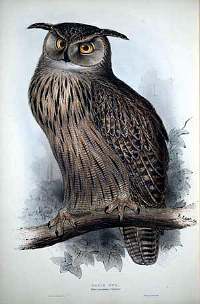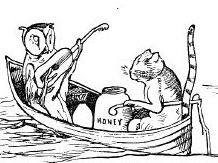Edward Lear
|
|
Missing image
Edwardlear.jpg
image:edwardlear.jpg
Edward Lear, 1812-1888

Eagle Owl, Edward Lear, 1837

Another Edward Lear owl, in his more familiar style
Edward Lear (12 May 1812 - 29 January 1888) was an artist, illustrator and writer known for his nonsensical poetry and his limericks, a form which he popularised. He was born in Highgate, a suburb of London, the 20th child of his parents and raised by his eldest sister, Ann, twenty-one years his senior. At the age of fifteen, he and his sister had to leave the family home and set up house together. He started work as a serious illustrator and his first publication, at the age of 19, was Illustrations of the Family of Psittacidae, or Parrots in 1830. His paintings were well received and he was favorably compared with Audubon. Throughout his life he continued to paint seriously. He had a lifelong ambition to illustrate Tennyson's poems; near the end of his life a volume with a small number of illustrations was published, but his vision for the work was never realised.
He did not keep good health. From the age of seven until the time of his death he suffered frequent grand mal epileptic seizures, as well as bronchitis, asthma, and in later life, partial blindness.
In 1846 he published A Book of Nonsense, a volume of limericks which went through three editions and helped popularise the form. In 1865 The History of the Seven Families of the Lake Pipple-Popple was published, and in 1867 his most famous piece of nonsense, The Owl And The Pussycat, which he wrote for the children of his patron Edward Stanley, 13th Earl of Derby. Many other works followed.
Lear's writing
Edward Lear's nonsense works are distinguished by a facility of verbal invention and a poet's delight in the sounds of words, both real and imaginary. A stuffed rhinoceros becomes a "diaphanous doorscraper". A "blue Boss-Woss" plunges into "a perpendicular, spicular, orbicular, quadrangular, circular depth of soft mud". His heroes are Quangle-Wangles, Pobbles, and Jumblies. His most famous piece of verbal invention occurs in the closing lines of The Owl and the Pussycat:
They dined on mince, and slices of quince
Which they ate with a runcible spoon;
And hand in hand, on the edge of the sand,
They danced by the light of the moon,
The moon,
The moon,
They danced by the light of the moon.
The "runcible spoon", a Lear coinage, entered the language and is now found in every dictionary.
Limericks are invariably typeset as five lines today, but Edward Lear's limericks were published in a variety of formats. It appears that Lear wrote them in manuscript basically in as much lines as there was room for beneath the picture. In the first three editions, most are typeset as, respectively, three, five, and three lines. The cover of one edition [1] (http://www.nonsenselit.org/Lear/BoN/index.html) bears an entire limerick typeset in only two lines, thus:
There was an Old Derry down Derry, who loved to see little folks merry;
So he made them a book, and with laughter they shook at the fun of that Derry down Derry.
In Lear's limericks, the first and last lines usually end with the same word, rather than rhyming. For the most part, they are truly nonsensical and devoid of any punch line or point; there is nothing in them to "get". They are completely free of the off-color humor with which the verse form is now associated. A typical thematic element is the presence of a callous and critical "they". An example of a typical Lear limerick:
There was an Old Man of A˘sta,
Who possessed a large Cow, but he lost her;
But they said, 'Don't you see, she has rushed up a tree?
You invidious Old Man of A˘sta!'
It is interesting to compare those two Victorian masters of nonsense, Edward Lear and Lewis Carroll. Lewis Carroll's "nonsense" is a reversal or parody of ordinary logic. He plays on the meaning of words, and his writing style itself is prosaic. Edward Lear's "nonsense" is a true absence of logic; he plays on the sound of words and his writing style is poetic. Among Lear's tremble-bembles and the chippy-wippy-sikki-tees can be found some very felicitous turns of phrase. Lear's self-portrait in verse, How Pleasant to know Mr. Lear, closes with this stanza, a pleasant reference to his own mortality:
He reads but he cannot speak Spanish,
He cannot abide ginger-beer;
Ere the days of his pilgrimage vanish,
How pleasant to know Mr. Lear!
External links
- Works by Edward Lear (http://www.gutenberg.org/author/Edward_Lear) from Project Gutenberg
- Edward Lear Home Page (http://www.nonsenselit.org/Lear) at nonsenselit.org (http://www.nonsenselit.org)eo:Edward LEAR
